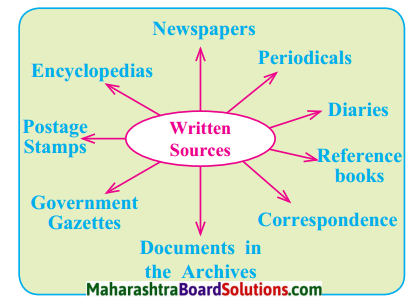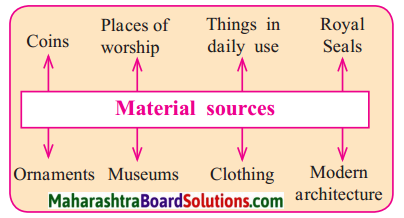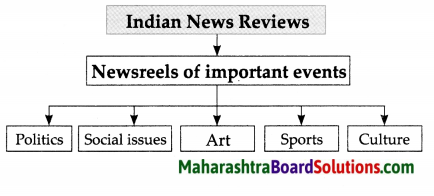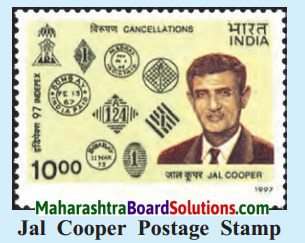Balbharti Maharashtra State Board Class 9 History Solutions Chapter 1 Sources of History Notes, Textbook Exercise Important Questions and Answers. Read More: INFY Pivot Point Calculator
Maharashtra State Board Class 9 History Solutions Chapter 1 Sources of History
Class 9 History Chapter 1 Sources of History Textbook Questions and Answers
1. A Choose the right option and rewrite the sentence.
Class 9 History Chapter 1 Sources Of History Questions And Answers Question 1.
The National Archives of India is situated at ______.
(a) Pune
(b) New Delhi
(c) Kolkata
(d) Hyderabad
Answer:
(b) New Delhi
![]()
Sources of History Class 9 History Chapter 1 Question 2.
The _______ is included among the Audio -Visual media.
(a) Newspaper
(b) Television
(c) All India Radio
(d) Periodicals
Answer:
(b) Television
Question 3.
______ is not included in physical sources.
(a) Coins
(b) Ornaments
(c) Buildings
(d) Proverbs
Answer:
(d) Proverbs
B. Identify the wrong pair and rewrite the corrected one:
Question 1.
(1) Jal Cooper – Philatelist
(2) Kusumagraj – Poet
(3) Anna Bhau Sathe – People’s bard
(4) Amar Shaikh – Art Collector
Answer:
Amar Shaikh – Art Collector
2. Write Short Notes:
Question 1.
Written Sources
Answer:
(i) Any historical document written by hand or typed or in printed form is called written sources.
(ii) The following are included in written sources: Newspapers, Periodicals, Diaries, Reference books, Correspondence, Document in the Archives, Government Gazettes, Postage Stamps, and Encyclopedias.
Question 2.
Press Trust of India (PTI)
Answer:
(i) After 1953, the Press Trust of India has been an important source of primary details of all important events and of articles on important subjects.
(ii) Press Trust of India has provided reports, photographs and articles on financial and scientific issues to newspapers. PTI has now started its online service.
(iii) During the 1990s, PTI started using the ‘satellite broadcast’ technology instead of teleprinters to send news all over the country.
(iv) This material is important for writing the history of modern India.
![]()
3. Give reasons:
Question 1.
The postal department tries to preserve the heritage and integrity of Indian culture through postage stamps.
Answer:
(i) Postage stamps reveal a lot to us about changing times due to the variety in the sizes of the stamps, the novelty in their subjects and colour schemes.
(ii) The Postal Department issues postage stamps on a wide variety of themes.
(iii) It issues stamps on political leaders, flowers, animals, birds, an event, or the silver, golden, diamond jubilees or centenary, bicentenary and tercentenary of different events.
(iv) It is therefore, a valuable repository of history.
(v) Thus the postal department tries to preserve the heritage and integrity of Indian culture through postage stamps.
Question 2.
Audio-visual media are an important source for writing the history of modem India.
Answer:
(i) Audio-visual means possessing sound and visual content; for example, films and television
(ii) We have channels like History channel and Discovery channel which telecast footage of historical events in multimedia.
(iii) With the help of satellites, live coverage of all political, social and cultural events is possible across the globe. This helps to create an accountable repository for future reference as well.
(iv) Video libraries possess a vast storage of historical information in audio-visual mode which becomes handy in writing the history of modem India.
Class 9 History Chapter 1 Sources of History Additional Important Questions and Answers
Choose the correct option from the given options and rewrite the statements:
Question 1.
Information and Broadcasting Department published ______, an annual reference book.
(a) India 2000
(b) Incredible India
(c) Indian Horizon
(d) Aspiring India
Answer:
(a) India 2000
Question 2.
The place where historical documents are _______.
preserved is called
(a) Library
(b) Store Room
(c) Archives
(d) History Room
Answer:
(c) Archives
Question 3.
Newspapers are considered the _______ pillar of democracy.
(a) First
(b) Second
(c) Third
(d) Fourth
Answer:
(d) Fourth
Question 4.
_____ has also produced various documentaries on prominent social leaders, on people who have made major contributions and about important locations in India.
(a) British Broadcasting Corporation (BBC)
(b) Reuters
(c) Indian News Review
(d) Bloomberg
Answer:
(c) Indian News Review
![]()
Question 5.
Aavahan is written on the backdrop of Sino- Indian war by the noted Marathi poet _____.
(a) Narayan Gupte
(b) Kusumagraj
(c) G.D. Madgulkar
(d) Namdeo Dhasal
Answer:
(b) Kusumagraj
Question 6.
Cooper edited _______.
(a) India’s Stamp Journal
(b) Indian Philatelic Magazine
(c) Stamp Synopsis
(d) The Journal of Philatelic Bureau
Answer:
(a) India’s Stamp Journal
Question 7.
After 1953, the ____ has been an important source of primary details of all important events.
(a) Union Trust of India
(b) Press Trust of India
(c) Information and Broadcasting Ministry
(d) Film and Television Institute of India
Answer:
(b) Press Trust of India
Question 8.
Duringthe 1990s, PTI started using ____ technology instead of Teleprinters.
(a) GPS Device
(b) Ultrasonic Gadget
(c) Radio Programming
(d) Satellite Broadcast
Answer:
(d) Satellite Broadcast
Question 9.
The Government of India started the Film and Television Institute of India at Pune in 1960 with the purpose of providing _______.
(a) Entertainment
(b) Public Education
(c) International updates
(d) Intra-societal information
Answer:
(b) Public Education
Question 10.
The Indian government issued the ______ stamp in 1977.
(a) Narsee Monjee
(b) Jal Cooper
(c) Birsa Munda
(d) Senapati Bapat
Answer:
(b) Jal Cooper
Question 11.
The Chhatrapati Shivaji Maharaj Museum is at ________.
(a) Delhi
(b) Mumbai
(c) Kolkata
(d) Chennai
Answer:
(b) Mumbai
Question 12.
The ______ issues postage stamps on a wide variety of themes.
(a) Publications Division
(b) Postal Department
(c) Income Tax Department
(d) Revenue Department
Answer:
(b) Postal Department
Question 13.
______ prints the notes.
(a) Reserve Bank of India
(b) Union Bank of India
(c) Philatelic Bureau of India
(d) State Bank of India
Answer:
(a) Reserve Bank of India
Question 14.
Empire of India Philatelic Society was founded by ______.
(a) Pherozeshah Mehta
(b) Mahzarin Banaji
(c) Jal Cooper
(d) Dinshaw Patel
Answer:
(c) Jal Cooper
Question 15.
PTI has provided reports, photographs and articles on ___ issues to newspapers.
(a) Therapeutic
(b) Financial and scientific
(c) Demographic and Topographic
(d) Environmental
Answer:
(b) Financial and scientific
Identify and write the wrong pair in the following sets:
Question 1.
(1) Powada – Oral sources
(2) Documentaries – Audio Visual Sources
(3) Coins – Material Sources
(4) Owis – Archaeological Sources
Answer:
Owis – Archaeological Sources
Question 2.
(1) India 2000 – Annual Reference book
(2) Indian News Review – News reels and documentariess.
(3) FTII – Radio Programmes
(4) Reserve Bank of India – Printing notes
Answer:
FTII – Radio Programmes
Question 3.
(1) Chhatrapati Shivaji Maharaj Museum – Mumbai
(2) Reserve Bank Museum – Pune
(3) National Archives of India – Calcutta
(4) Film and Television Institute of India – Pune
Answer:
National Archives of India – Calcutta
![]()
Do as directed.
Complete the concept map:
Question 1.
Answer:

Question 2.
Answer:

Question 3.
Answer:

Question 4.
Answer:

Write short notes:
Question 1.
Coins
Answer:
(i) We can also understand history with the help of coins and the changes in the printing of currency notes.
(ii) The Reserve Bank of India prints the notes. It has its headquarters in Mumbai.
(iii) The coins from 1950 to those used at present, the metals used for making them, their different shapes, and the diversity of subjects on them together help us to understand the important contemporary issues in India; For example coins to convey the message of population control and coins communicating the importance of agriculture and of farmers.
Question 2.
Jal Cooper
Ans
(i) The Indian government issued the ‘Jal Cooper’ stamp in 1977. Jal Cooper was an internationally acclaimed philatelist, i.e. an expert on the subject of ‘postage stamps’.
(ii) Bom in a Parsi household in Mumbai, Cooper edited ‘India’s Stamp Journal’.
(iii) He was the founder of the first Philatelic Bureau in India, an office that collected stamps. He founded the ‘Empire of India Philatelic Society.
(iv) He went on to write many books on this subject. He gave a scientific bent to his hobby.
(v) He played a pivotal role in taking the study of Indian postage stamps to the international level.
(vi) Having started his career as a postage stamp collector, Cooper achieved the expertise of a philatelist at the international level.
(vii) The postage stamp on Jal Cooper is an important source to understand his significant contribution to this field.
Explain the statements with reason:
Question 1.
Museums reflect the unique heritage of a state.
Answer:
(i) All states of India have museums that depict the characteristics and display the cultural and social heritage of the state.
(ii) They enable us to understand history; For example, the Chhatrapati Shivaji Maharaj Museum at Mumbai and the Reserve Bank Museum in Pune city.
(iii) Apart from the Government Museums, some private collectors also set up their own museums.
(iv) They are based on distinctive subjects; For example, coins, notes, lamps and nutcrackers in different shapes, cricket equipment, etc.
Read the passage and answer the questions.
The Indian government issued the ‘Jal Cooper’ stamp in 1977. Jal Cooper was an internationally acclaimed philatelist, i.e. an expert on the subject of ‘postage , stamps’. Bom in a Parsi household in Mumbai, Cooper edited ‘India’s Stamp Journal’. He was the founder of the first Philatelic Bureau in India, an , office that collected stamps. He founded the ‘Empire of India Philatelic Society’. He went on to write many , books on this subject. He gave a scientific bend to his , hobby. He played a pivotal role in taking the study of Indian postage stamps to the international level, , Having started his career as a postage stamp collector, Cooper achieved the expertise of a philatelist at the international level. The postage stamp on Jal Cooper , is an important source to understand his significant ,contribution to this field.
![]()
Question 1.
Other than Philatelies which other streams of vocation deal with sources of history?
Answer:
Other than Philatelies, other streams of vocation which deal with sources of history are: Numismatics, Museology and Archaeology.
Question 2.
Name the two institution founded by Jal Cooper.
Answer:
Two institutions founded by Jal Cooper are:
(i) The First Philatelic Bureau in India.
(ii) Empire of India Philatelic Society.
Question 3.
Why do you think the government of India issued a postage stamp in the name of Jal Cooper?
Answer:
Jal Cooper is accredited to raise Indian Philatelies to an international level. He nurtured his hobby with great expertise and became a renowned Postage Stamp Collector. To honour his contribution, the government of India issued a postage stamp in his name in 1977.
Answer the following questions in detail.
Question 1.
Which information among print media is considered authentic and trustworthy?
Answer:
Among the print media, the information contained in the annual issues of the Publications Division of the Government of India is authentic and trustworthy.
(ii) For example, the Information and Broadcasting Department published ‘INDIA 2000’, an annual reference book.
(iii) ‘ This reference book is created under ‘Research, Reference and Training Department’.
Question 2.
Which sources are included in material sources?
Answer:
The following sources are included in material sources:
- Coins
- Places of worship
- Things in daily use
- Royal seals
- Ornaments
- Museums
- Clothing
- Modern architecture.
Question 3.
Write in brief about museums in India.
Answer:
(i) All states of India have museums that depict the characteristics and display the cultural and social heritage of the state.
(ii) They enable us to understand history (e.g., the Chhatrapati Shivaji Maharaj Museum at Mumbai, Reserve Bank Museum in Pune city).
(iii) Apart from the Government Museums, some private collectors also set up their own museums.
(iv) They are based on distinctive subjects; For example, coins, notes, lamps and nutcrackers in different shapes, cricket equipment, etc.
Question 4.
Write briefly about ‘Indian News Review’.
Answer:
(i) An institute called Indian News Review has produced various newsreels on important events in politics, social issues, art, sports and culture.
(ii) This department has also produced various documentaries on prominent social leaders, on people who have made major contributions for the country and about important locations in India.
(iii) These news releases and documentaries are useful for studying the history of modern India.
Question 5.
Oral Sources
Answer:
(i) These sources include folktales, folksongs, proverbs, ballads and owis (Marathi verses in the oral tradition).
(ii) Activists were inspired by the powadas of Lok shahir, Anna Bhau Sathe and Shahir Amar Sheikh during the Sanyukta Maharashtra Movement.
![]()
Question 6.
Identify the picture and give relevant information.

Answer:
- The person depicted in the picture is Jal Cooper, an internationally acclaimed philatelist from India.
- Cooper edited ‘India’s stamp Journal’. He was the founder of the First Philatelic Bureau in India, an office that collected stamps. He founded the ‘Empire of India Philatelic Society’.
- The Government of India issued the Jal Cooper Stamp in 1977.